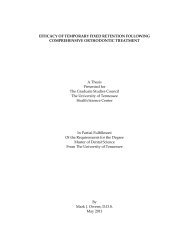BEVACIZUMAB EFFECT ON TOPOTECAN PHARMACOKINETICS ...
BEVACIZUMAB EFFECT ON TOPOTECAN PHARMACOKINETICS ...
BEVACIZUMAB EFFECT ON TOPOTECAN PHARMACOKINETICS ...
Create successful ePaper yourself
Turn your PDF publications into a flip-book with our unique Google optimized e-Paper software.
efficacy study, CPT-11 was equally effective with or without pretreatment with A4.6.1.<br />
The authors concluded that tumor vascular function and tumor uptake of anticancer drugs<br />
improved with VEGF-blocking therapy. Finally, as discussed in the second paragraph of<br />
section 1.1.3, increased PTX concentration in two solid tumor tissues after a single dose<br />
of BEV (5 mg/kg) has recently been observed accompanying the downregulation of<br />
vascular permeability [49]. Consistent with the increased intratumoral PTX<br />
concentration, the antitumor activity of BEV at 5 mg/kg in combination with PTX at 20<br />
or 30 mg/kg was significantly higher than that of either agent alone. The authors<br />
concluded that the synergistic antitumor activity of PTX and BEV in combination may be<br />
a result of the increase in PTX concentration in tumor resulting from the downregulation<br />
of vascular permeability when co-administered with BEV.<br />
The underlying reasons for this paradoxical phenomenon have been discussed by<br />
numerous investigators. As mentioned in section 1.1, the poorly organized and irregular<br />
tumor vasculature leads to reduced blood flow, heterogeneous vessel wall and interstitial<br />
hypertension and results in inefficient delivery of cytotoxic drugs into tumors. The uptake<br />
of cytotoxic drugs [91] in tumors is primarily determined by the total number of<br />
functional blood vessels inside the tumor and the transport efficiency of each individual<br />
vessel. The treatment of anti-angiogenic agents dynamically affects the tumor vasculature<br />
and the consequent cytotoxic drugs transport into solid tumors. Besides, the optimal<br />
dosing and scheduling of angiogenesis inhibitors when combining with cytotoxic drugs<br />
are critical for the effect of angiogenesis inhibitors on cytotoxic drug penetration and<br />
efficacy, as extensively suppression of tumor vessels may ultimately reduce the cytotoxic<br />
drug penetration and efficacy. Indeed, improved clinical responses were observed when<br />
conventional chemotherapy was combined with low dose BEV as compared to high dose<br />
BEV [98]. Improved intratumoral cytotoxic drug concentration and penetration were also<br />
observed when given low dose of sunitinib as compared to high dose sunitinib [51, 148].<br />
In addition, chronic treatment with antiangiogenesis therapy eventually reduces tumor<br />
blood perfusion and increases tumor hypoxia in experimental animal studies [150, 151],<br />
indicating that uninterrupted treatment with the anti-angiogenic drug, although perhaps<br />
maximally effective as a monotherapy, may not be optimal for tumor vascular<br />
normalization-enhanced combination chemotherapy. Furthermore, as Jain [14] proposed,<br />
either less effect or over pruning of tumor vessels by angiogenesis inhibitors leads to no<br />
change on or reduced total functional blood vessels in tumors and resulting in no change<br />
on or decreased cytotoxic drugs transport. Even in the tumor vasculature normalization<br />
window, decreases in vessel permeability to cytotoxic drugs may overwhelm the<br />
favorable changes in vessel morphology for drug penetration and result in reduced drug<br />
levels in tumors as evidenced and discussed by Devineni [145]. Only the favorable<br />
effects on drug transport overweighting the unfavorable effects will result in an increase<br />
in drug transport capacity of the tumor vasculature and microenvironment. Increasing the<br />
total number of functional blood vessels, increasing the blood perfusion and decreasing<br />
the interstitial pressure are examples of the favorable effects, while reducing the blood<br />
vessel permeability and decreasing the total blood vessels are examples of the<br />
unfavorable effects. The observation of the decreased intratumoral TMZ concentration<br />
and penetration by Gallo et al. in rat glioma model is correlated to the decreased MVD in<br />
tumor. Thus the decreased intratumoral concentration of TMZ may due to the<br />
15
















